
by E. Alan Meece
author of The Philosopher's Wheel
So what is the Tree of Life, and why should we learn about it?
Will Parfitt's book The Elements of the Qabalah is very good. On the book's back cover, he says it explains:
I am very interested in "realizing my creative potential." Mentioning such practical things on the cover helps to sell the book too. But he also says that the Qabalah's Tree of Life, from the Jewish mystic tradition, is a "map of consciousness." I like maps of consciousness for their own sake; for their truth and beauty. Jesus says "seek first the Kingdom of God and His righteousness, and the other things will be yours as well." (Matthew 6:33) When I see someone I admire, or hear beautiful music, or appreciate amazing artwork, or experience the restorative power of Nature, it gives me life. It uplifts my spirit. I may not be thinking about improving my life, but it happens anyway.

The Tree of Life is beautiful, and so are other maps of consciousness. I am thrilled to discover connections between them, and I'm going to share a few of these discoveries a little later. Other peoples' discoveries are beautiful too, such as the ones our ministers share. Maybe they can inspire you to enjoy and discover them too. As Will Parfitt says, "the most important thing is to make your own connections." (page 39) If you find a correspondence that is more appropriate to you than the ones given in a book, then it will help you work with the map. But it may also be useful, he says, to see why certain correspondences are more universal.
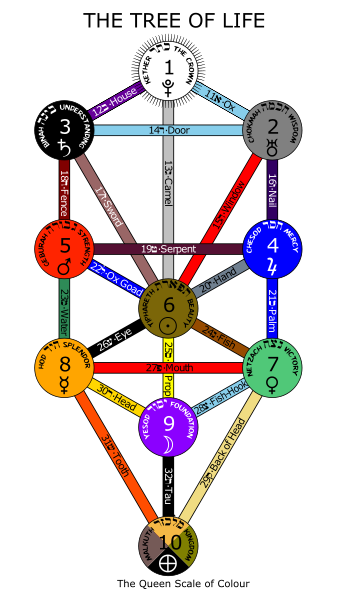
"It is important to remember," Parfitt says, "that the map is not the territory." (page 29) It is only a guide to experience. The more maps we can connect and fit together, the better picture of the territory we get. I have several maps of the world on my wall. They all show San Francisco, but they don't all show San Jose. Does that mean San Jose doesn't exist? No, it means that our picture improves with more maps, and the more they correspond with each other the better.
Joseph Campbell in his book Primitive Mythology writes of "the fundamental unity of the spiritual history of mankind" (page 5), and how in our times we can break through our differences to reach a common understanding.
The connections between different maps also mutually validate them.
In college I developed my own map of consciousness called the philosophers wheel, which is now the title of my website domain. My philosophy teacher suggested I check out what maps already existed, but I found the various philosophies scattered with no relationship between them. So they were not really maps at all, because a map describes a continuous territory! That's what my new map did by putting all the philosophers into a wheel with a cross inscribed inside it.
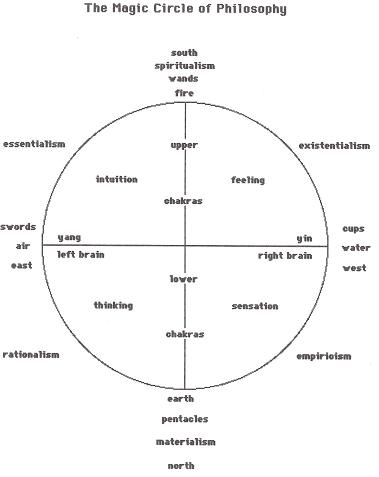
Noone had ever done that before with philosophy. But I soon found that my map coincided with many others from other traditions. The Tree of Life concides as perfectly with the philosophers wheel as could be imagined. The basic idea of all these maps is that one axis runs between the heavens and earth (often called the axis mundi), representing the relation of the spiritual to the more material. The other axis puts form and limitation on the left side, while the right side is free-flowing and diffuse. Like the various philosophers, the 11 circles or spheres on the Tree of Life (also called fruits) are gradations between these axes on the wheel. The 3 circles on the left of the Tree range from spiritual to more mundane ways of mental structuring, forming and limiting, while the 3 circles on the right range from spiritual to more mundane kinds of free-flowing, feeling energy.
.jpg)
The Tree of Life is very flexible and brings greater clarity to many fields. Although I completely agree with the basic structure of the Tree, I don't always agree with the various symbolic correspondences other people make to it. Like Will Parfitt said, I made my own connections. I could not make sense out of how the tarot cards were supposed to be aligned with the 22 pathways that connect the circles on the Tree. They didn't seem to jive with the basic directions of the Tree and the philosophers wheel. After about 20 years I finally figured it out. I just switched the direction in which the cards were aligned from down the Tree to up! I was so thrilled to make this discovery.
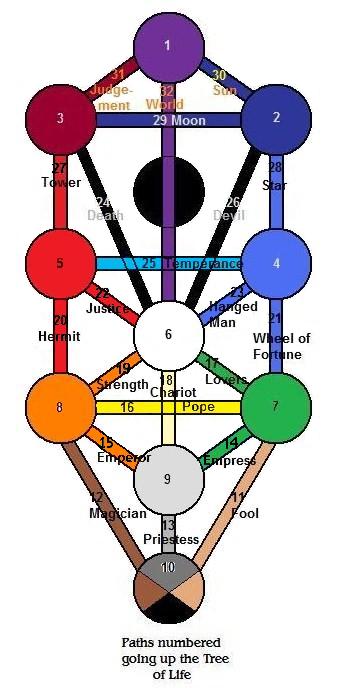
Robert Place wrote a book on The Tarot which gave me the key. He said that the major arcana, the 22 cards that correspond to the pathways, describe a hero's journey to enlightenment. Joseph Campbell demonstrated that the hero has a thousand faces. Almost all stories are versions of this journey, in fact. The 22 major cards of the tarot are 22 phases of the journey. If we run them up the Tree of Life, instead of down from the top as is usually done, the paths of the Tree become the spiritual path of the seeker climbing out of the mundane world of society at the bottom of the Tree back up to God at the top. The cards numbered from 1 to 10 in 4 suits symbolize God emanating down into the world through the 10 numbered circles, and the 16 face cards are the 16 types of people in the worldly kingdom at the bottom, just like the 16 Jungian MBTI types.
More on the Tarot and the case for running the cards UP the Tree
I also discovered I wasn't the first to reverse the direction of the cards, although earlier approaches were somewhat jumbled. In 1923 Frater Achad made one which was prominent enough to disturb the great occultist Aleister Crowley, who wrote on page 7 of his book Magick in Theory and Practice, "One who ought to have known better tried to improve the Tree of Life by turning the Serpent of Wisdom upside down!" Binah the supernal understanding is connected with Tipareth, the human consciousness, by The Lovers, he wrote. "To replace it with the Devil is either humor or plain idiocy." And Strength balances Majesty and Mercy; "what sense is there in putting Death, the Scorpion, in its stead?" But that is exactly what I do! In my revised correspondence, Death and The Devil correspond to what's called "the abyss," where we face the final barriers to spiritual realms in our climb up the Tree. And Will Parfitt agrees, even though he uses Crowley's Golden Dawn correspondences. "Daath (which sounds like Death) is the unnumbered sphere that resides in the Abyss between the Supernal Triad and the lower Tree. It is said to be the access point to the reverse side of the Tree where all the demons that bring dis-ease into our lives exist." (page 106).
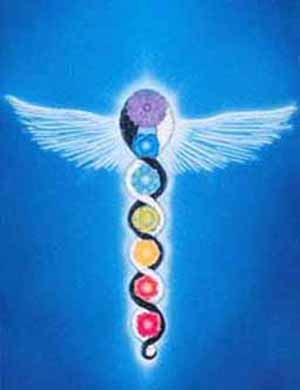
The other great connection I found was to the chakras. In this case the experts I read on the Kaballah entirely agree with me. According to Parfitt, "Eastern systems delineate seven major power points that are called 'chakras' and these correspond to the planes on the Tree of Life." (page 61) Charles Ponce writes, the circles on the Tree "actually diagram a yogic process for meditation & should be so used." (page 155). "This is vitally important to understanding the Qabalah," writes Parfitt, "for it is through our bodies that we are able to bring anything into manifestation." (page 61-62). Ponce explains that the circles along the material to spiritual axis in the middle of the Tree or the spine "are subtle centers in the same sense that the chakras are." (page 155).
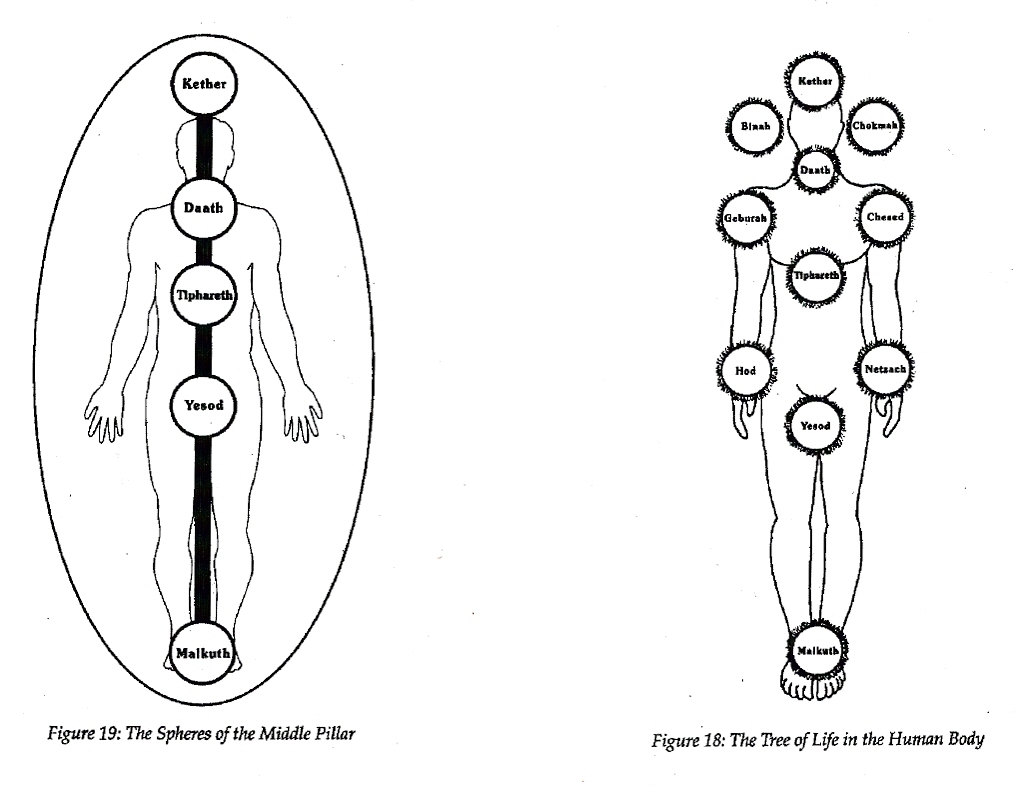
We're going to climb the Tree in a moment, but first something to keep in mind. Quoting Parfitt, "If we compare the chakra system to the Tree of Life, we can see that some of the energy centers have more than one sphere corresponding to them. Some of the chakras are concerned with outer balance, and these have a single sphere associated, the other half of the polarity being outside the individual person. Those concerning balance within the individual have more than one sphere associated." (page 63)
Most of the chakras are actually marked by indentations in our bodies, where we can connect to them most directly. I won't ask you to touch your first chakra, since that might be impolite, but focus on the base of your spine, and if you're a guy this is also the base of your penis that focuses your sexual energy. On the Tree this center is #10 and is called Malkuth the worldly kingdom. Being a single sphere, you can improve your ability to relate to the physical world by focusing on it. Next up is the second chakra in the middle of your stomach, so touch there now. This is also a single sphere #9 called Yesod, and is sexual too, especially for women, but also releases movement and generosity. Next touch your navel, your third chakra. It has two spheres on each side # 7 & 8 called Netzach and Hod, and by focusing here martial artists balance and center their own power. This is marked by your navel, also called "the pit of the stomach." If you get punched here you can get knocked out, since your power is also your vulnerability. But touching or paying attention here can help you balance and coordinate all your physical movements and give them more energy.
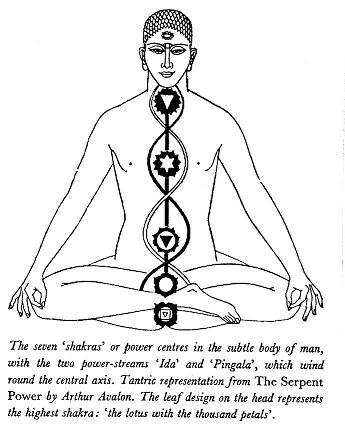
Now bring your finger up to the hole right below your chest bone that marks your heart center. Note it is a V-shape pointing upward. Feel it. The heart is a soft place, like crimson and velvet, the center of your soul. Focus here at the single sphere called Tipareth to make sure your outer relationships are loving and authentic. But it's also connected with spheres #4 & 5 on each side called Chesed and Geburah, because the heart also balances opening to others with your own inner gyroscope and your own heart's desire. It is compassion, but also your immune system. The next chakra at the base of your throat is a huge V-shaped indentation pointing downward. It is associated with the single but hidden sphere Daath, where you share your knowledge with others, but you have to watch it carefully since as Jesus said "it's what comes out of your mouth that defiles you." (Matthew 15:11) Of course it's also true that what goes in can defile, since you are what you eat, and communication requires good listening too.
Find your third eye if you can, which is marked by a small V-shape that again points downward. It is connected to two spheres #2 Chockmah and #3 Binah and synchronizes the two sides of the brain so you can receive deep spiritual insights. There is also a hole at the top of your head. Don't press too hard, but if you can find it, it is like finding a direct connection to God at your crown chakra and the sphere #1 of Kether.
My discoveries really started to blow my mind when I connected all these systems to my favorite piece of music. Bach's Toccata in F Major BWV 540 for organ is also a powerful map of consciousness. It connects especially to the chakras, since it proceeds in seven distinct ascending stages to a grand climax, and each small segment also relates to a major tarot card in the spiritual journey up the Tree. If you came to the Summer Solstice Celebration I led a spiral dance to the two canons or imitation themes in the first two snake-like chakra sections, which resemble the double helix of DNA that transmits life. These canons are like 2 vortexes spinning in opposite directions. In the first section the left hand imitates the notes played by the right hand for 54 bars, and then the right hand imitates the left for 54 bars in the second. They represent the two fundamental phases of the seasons, and also the 2 serpents winding themselves in contrary directions around the chakras. It even connects to the most famous Hindu myth of creation, the Churning of the Ocean. This myth says that as 54 gods or devas pulled the snake in one direction around the sacred mountain, and then 54 asuras or demons pulled it in the other, the ocean of life was milked, forming the earth and the Milky Way galaxy. The myth is depicted at Angkor in Cambodia, the largest temple complex in the world.
The 54 devas and asuras pulling the snake in opposite directions is depicted by 54 statues on each side along the walkway at the South Gate to Angkor Thom. Their number is also based on the Sanskrit alphabet which has 54 male or Shiva letters and 54 female or Shakti letters.
In your handout is a picture of Leonardo Da Vinci's Vitruvian Man that shows the chakras.

Remember that Leonardo's picture reveals the golden ratio of 1.618 to 1 which shows up in many living things and natural phenomena and in many great works of art and music. Leonardo places the Man inside an overlapping square and circle. The center of the square is located at the 1st or 2nd chakra, the groin, where we focus on the physical. The 3rd chakra of the solar plexus is at the center of the circle, which represents the soul. This is also the divine proportion or golden ratio point along the backbone inside the square. The heart chakra is at the divine proportion point on the same axis within the circle. This matches Bach's Toccata in F, in which the central bar #219 is in the middle of chakra 3, and the divine proportional bar #271 is in the middle of the heart chakra. The Toccata is a map of the soul's journey.
I long wondered why this heart chakra section of the Toccata in F features five repeats of its second theme, while the 3rd and 5th chakra sections have only four. The Da Vinci Code gave me the answer. The pentacle (five-pointed star) is featured prominently there as the symbol of Venus, the goddess of love and the sacred feminine. Brown pointed out that Venus passes closest to Earth exactly 5 times every 8 Earth years, after which it returns to the same place in the zodiac. It also makes exactly 5 rotations on its own axis between each passage. Jeff Andrews points out that Venus goes around the Sun 13 times in those 8 years, and that 5, 8 and 13 are fibonacci numbers (which reveal the golden ratio of 1.618). As you can see from our tables, Venus rules the heart chakra.
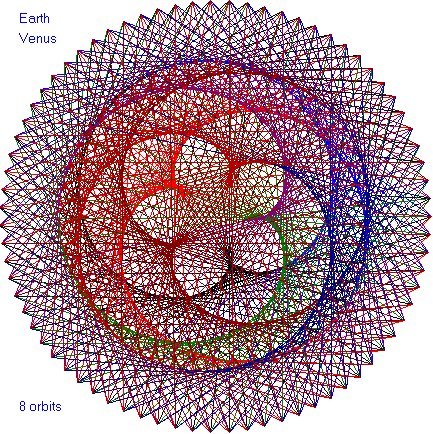
The heart chakra is said by the Hindus to have "12 petals." There are exactly 5 geometric regular polyhedrons or Platonic solids, and no others can exist. One of these is the Dodecahedron or 12-sided polygon, in which each face has 5 sides. Each of the 5 geometric solids was linked by Plato to an element; for the dodecahedron it is ether or spirit, called the 5th element.
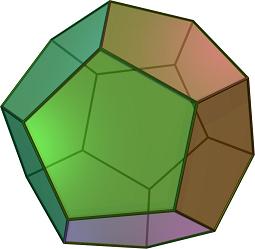
The dodecahedron, associated with the 5th element and the heart chakra, has 5 interior angles of 108 degrees each (the number of gods on the sacred Mt. Meru, and the total # of bars in the first two chakra sections of 54 bars each), and these angles add up to 540. By an amazing coincidence, this is the Schmeider catalogue or BWV number of Bach's Toccata in F. This number was chosen a century after Bach died. The Key of F is considered the key of the heart chakra, which is indicated in the Toccata in F by the five wandering repeats in the uplifting theme, and represented by the 5 faces of the dodecahedron, the Platonic solid corresponding to the 5th element, the quintessence, the heart chakra's element of Spirit. Venus, the heart's ruling planet, moves with the Earth in a 5-pointed rhythm, exhibiting the fibonacci sequence as it does so, as do the pentagram and pentagon. 540 degrees is also 1 and a half times around the zodiac or the circle. If you start at 0 degrees Aries, then 540 degrees equals the beginning of Libra, a heart-chakra sign ruled by Venus. The letter F stands for Five, Four, and Five-Forty; and the F tone is a fourth, and also an inverted fifth tone.
Please visit my website philosopherswheel.com Enjoy your journey!
Dan Campolieta performs Toccata in F